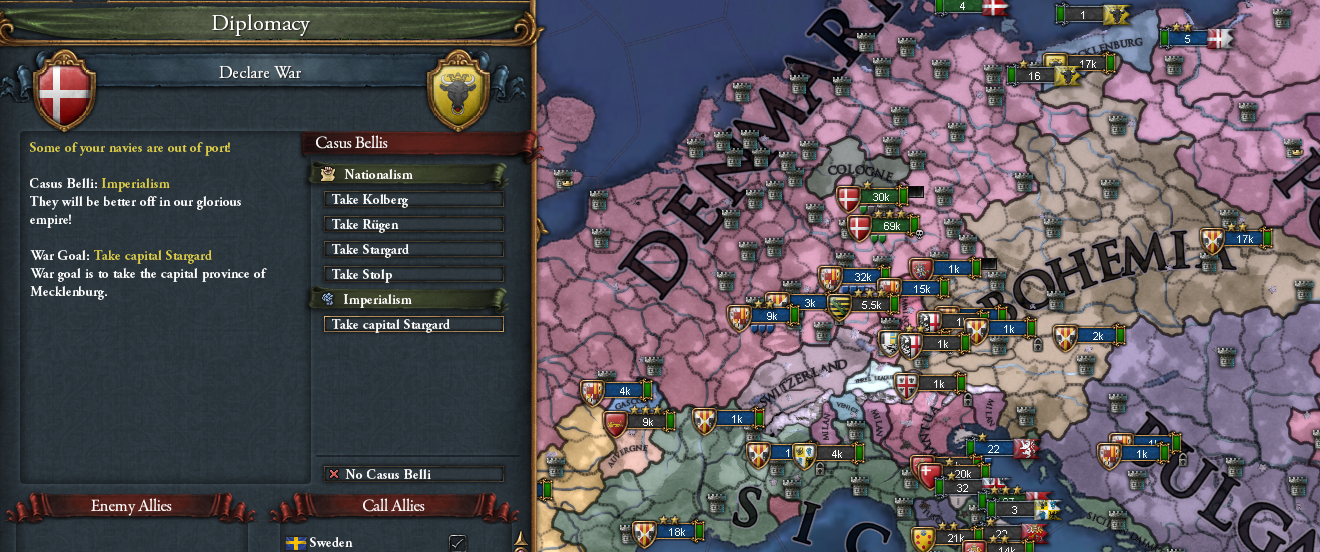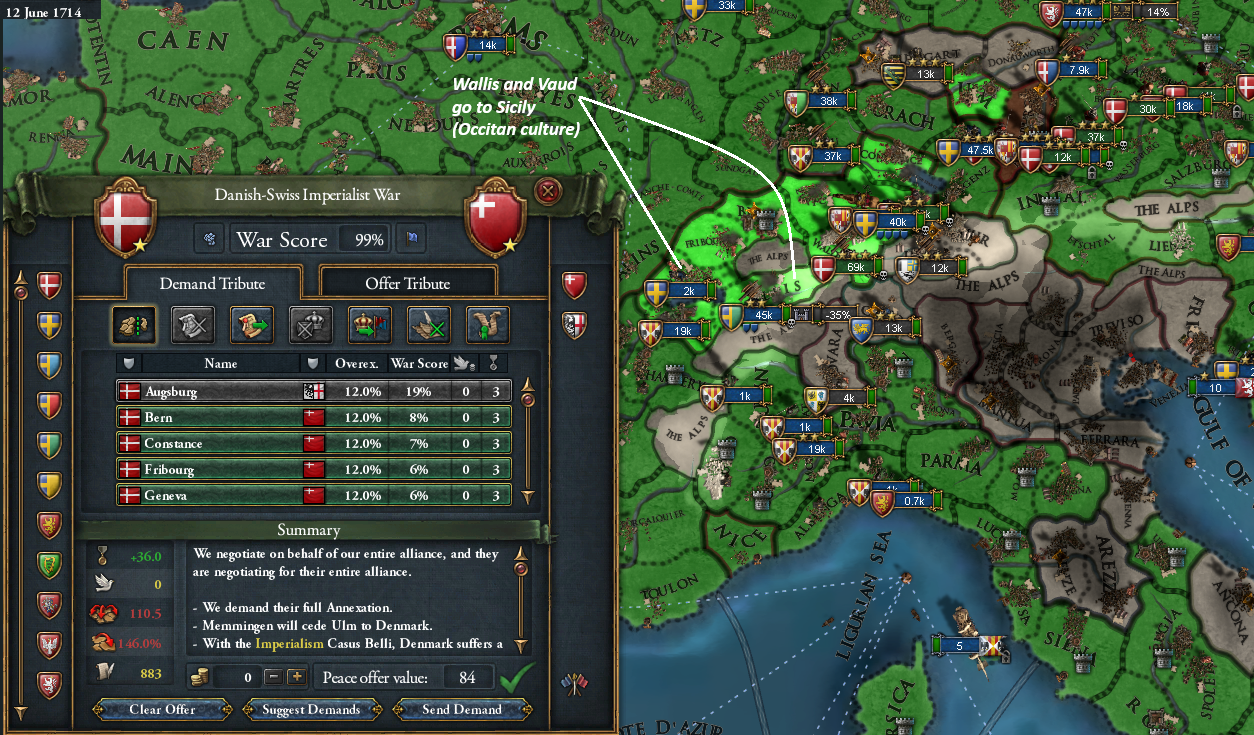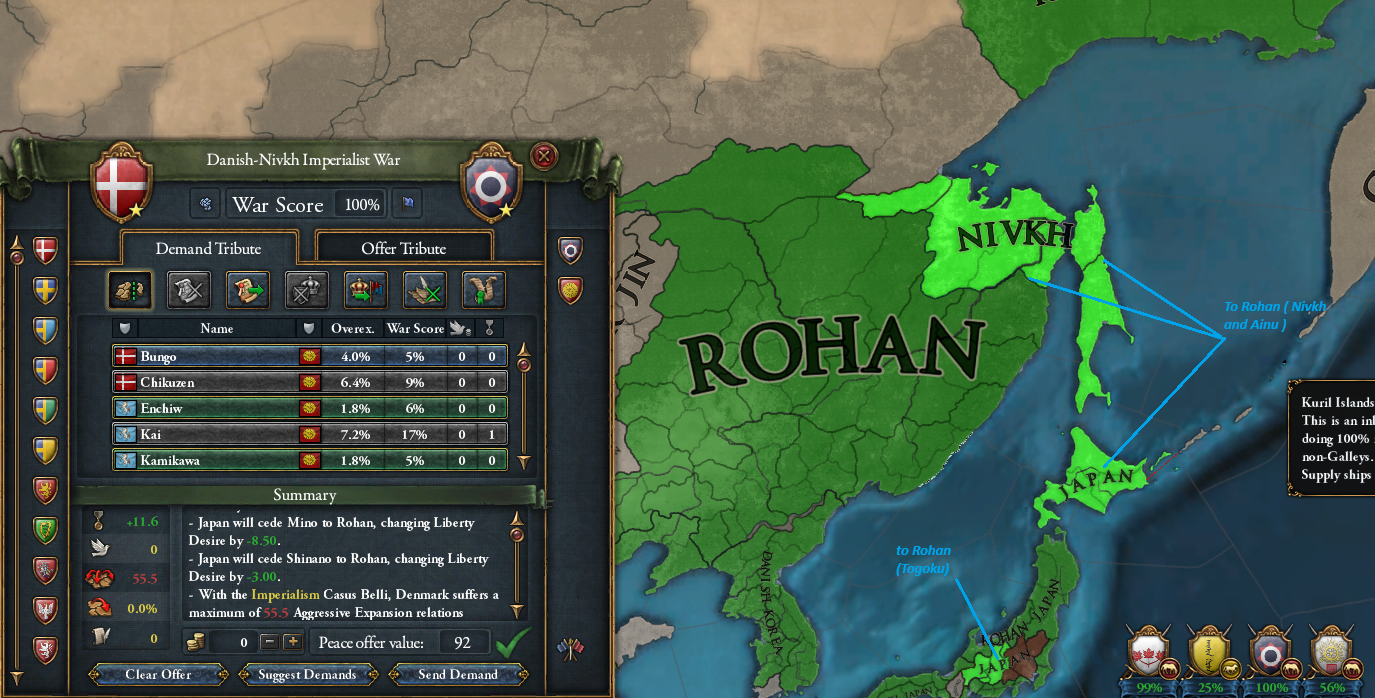Chapter 29: A University for Women Too (1720-1730)
In the last two Chapters, Christian V the strict took many steps towards building a post-conquest world. Some of those actions, particularly ceding land to Jolof and Syria, reminded people (
@jak7139 ) of his mercurial ancestor Niels Wittelsbach . And he opened the decade with even more of those counter-intuitive actions, with the return of Grain Coast province to Kong, and Swellendam to Kilwa.
In the case of Swellendam, he needed a way to give the province to Sudafrica, who accepted the Swahili culture there, but was two tiles away . In the case of Kong, he needed a willing patsy to cede more of Spain's trade company provinces to. And we describe Kong here with the term patsy because their ultimate fate would follow that of Jolof, who received the Spanish provinces, but now found itself at the receiving end of a declaration of war asking for those same provinces back.
The Jolof war kicked off the latest batch of wars, with declarations on Nivkh, Kham , Canada and Later Jin coming soon after ( basically at 1 month intervals as required by diplomatic rules ) . When choosing those targets, Christian had to stay clear of any Sunni nations in Asia that would have called Gurkani as Defender of the Faith. He wanted the next war with Gurkani to be with them as a full belligerent, to maximize land gains.
And by the close of the first year of the decade, the Jolof war ended with its full annexation directly to Mauretania
Our Emperor was then looking forward to some more annexations when fate struck and he passed away from natural causes at the age of 67 . He was succeeded by 25 year old Christian VI.
Immediately preparations for the full education of Christian VI at Kyoto were begun.
Peace was made first with Nivkh and their guarantor Japan, with Rohan taking all the gains. Then war was declared on Otomo who held Kyoto at the time. While that was was prosecuted, Canada was forced to give back most of the land she took recently from Breton Canada back to the Bretons .
Ant then peace in Japan was concluded , with Kyoto returning to Denmark . Japan was made to lose more provinces, pushing them almost completely to the South Island of Kyuchu . A quick upgrade to the Imperial City got our Christian to 5/3/3 .
On his return trip to Europe, he stopped by the Citadel of Bam to visit its Prussified population, and reaffirm to its inhabitants their full rights as Danish citizens of the state of Kerman (the province was turned to a State to allow religious conversion earlier, and the Emperor decided it would not return to Trade Company status).
ANd when he arrived to Kent, he celebrated his nuptials with Sofie von Haseldorf of Ghent, who bore him an heir Frederik 4/4/6.
And it was from Kent that he directed peace treaties ending this current batch of wars
The annexed lands went to various Asian subjects, and in almost all cases he had to force-feed the provinces to the Clients when their over-extension hit over 100%. Then without resting much, he began another batch of wars, picking on Vijayanagar, Ternate ( who had received many wrong-culture Spanish provinces in teh last chapter), and Saxony .
The absence of a significant break between the wars meant the Danish people were exhausted from the constant fighting and Christian had to spend resources to fight the exhaustion ( this was not a problem in the days Denmark was a hegemon) .
And if Denmark , with her vast resources, was exhausted, the vassals who were over-extended were doubly so. And that meant constant warring with rebels in all the Client States, to the point that Danish manpower was starting to decline ( but was still high ) . And so Christian began a vast construction project for Soldier's houses in many EUropean provinces. He then presided over the final annexation of Saxony as well as portions of Nepal .
And our young Emperor was considering the options of peace with the remaining enemies when fate struck and he died of (un?)natural causes.
He was 27 years old, and his reign was a brief two and half years. It was so short, that he did not have enough time to earn an adjective, and immediately people began to refer to him as Christian VI the "short-lived".
Christian left behind his new wife Sofie as regent for their infant son Frederik . With a potentially long regency of 14 years, the skills of the Consort, something that Danes had rarely bothered with , became relevant. And immediately a debate sprung up in the Cabinet on whether the Regent should make the customary trek to Kyoto to further her education. Was it worth it? some asked. How much could she improve in 14 years? they whispered. Others wondered if the Japanese would take offense at having a woman enter the Imperial city. And then some raised the issue of her ability to travel that far. But she quickly put all that to rest, showing off her skills as a Navigator and reassuring everyone that she was more than up for the job. But since Kyoto was currently owned by Denmark ( her late husband forgot to sell it back in the last peace lull), that trip had to wait till the current wars ended. And luckily for the regent, she was soon able to implement Napoleonic Siege warfare in the military, wich helped to speed up sieges significantly

The first fruits of that ability were a peace with Portugal, in which they ceded all their North African Forts to Denmark, who later gave them to Mauretania.
Then it was Vijayanagar who signed away their existence
Finally , Ternate signed a partial peace. In it they returned the Papuan culture provinces they initially got from Spain to Denmark, who created out of them the new Client State of Pacifica. The name was in honor of the nearby Ocean and an
alt-history nation known for its peaceful expansion.
The new nation of Pacifica would later become a favorite of historical trivia buffs as the only Client State not headed by a Wittelsbach ( its dynasty was that of the consort , the von Haseldorfs). And at the time of its founding, it was widely believed to be the last Client State that would be created.
The addition of Pacifica put more strain on the diplomacy department, and made it more urgent for the Regent to improve her skills in that regard. So after selling Kyoto to Ashikaga, war was declared on them in May 1725 .
A few months later, Kyoto was in Danish hands and Sofie became the first (and so far only) woman to benefit from the Kyoto education
While that went on, there was a war waged on Korea. And on the REgent's trip back from Asia to Denmark, she stopped by Africa and directed a fake war on Kong, who was forced to accept the remaining Spanish Trade Company provinces in the region.
But unfortunately our Regent forgot to renew the Warning on Japan, and the latter ended up declaring on and annexing Ashikaga.
That unfortunately took away one of the three Kyoto recipients , making another war harder to get without a truce break.
After that, the war with Korea was wrapped up, finishing off Qi , Ottoman Australia ( who had recently gained independence) and Korea itself.
Denmark kept the Korean culture provinces (one in the peninsula, and one in East Timor) , while Pacifica got the Papuan culture provinces and Tierra Austral unified her island.
After a brief respite in which Kyoto was sold to Otomo, another batch of wars was started against Jenne ( Africa) , Colima ( Central America) and Mantua ( Europe).
Colima was a quick war and ended up with New Spain taking the Pacifica coast of Mexico.
This was followed by war on Otomo and then a quick peace with Otomo and Japan
From Otoma, Denmark took Kyoto of course , and Sofie made her second trip to Japan earning skills of 4/6/6 . Japan was made to release Ashikaga as an independent nation, and was made to cede all her land on Kyushu. That relegated Japan to their old capital of Musashi and made them separate from the other two Japanese nations. Sofie's plan was to prevent wars of subjugation or annexation between the three nations, and that made planning future Kyoto trips easier. Unfortunately for her, the peace with Japan releasing Ashikaga gave truces that would expire after the Regency ends.
On her return to Europe, she celebrated to annexation of Cologne to DEnmark and much of Mantua to Sicily, leaving a small number of provinces near the Alps outside Danish control.
Then Jenne was made to disappear from the map, splitting her provinces between Nigeria and Mauretania.
At that point Denmark had the ability and option to become Hegemon again, since 20 years had passed since loss of Hegemony happened after ceding Spanish land to Jolof. But the Empress Regent held back for now. There was one last concession war to be made, and that was against Syria. That should happen early in the next decade. And then Denmark can resume her hegemony .
But actually there was also one other concession to be made, and that was a lone Spanish province in the Philippines that somehow got missed in the Ternate concession war. That was quickly taken care of by giving it to Pangasiana as part of a new war on Madyas
The war with Madyas was ongoing as the decade ended. ANd the start of 1730 brought with it another technological advance, and the chance to pick new ideas for Denmark. And our Empress Regent did not hesitate in choosing Quantity ideas to boost Denmark's power relative to her subjects, and allow even more armies to police the globe.
With her subjects well under control, Denmark is just a few wars away from completing the world conquest and establishing permanent peace.












































































